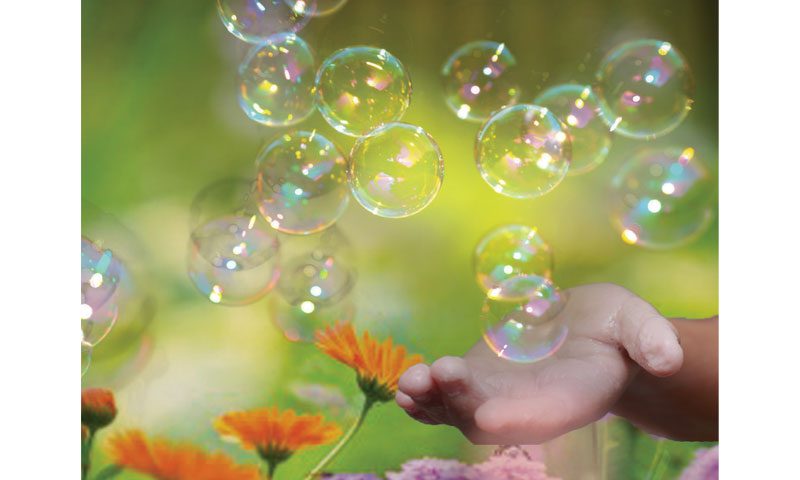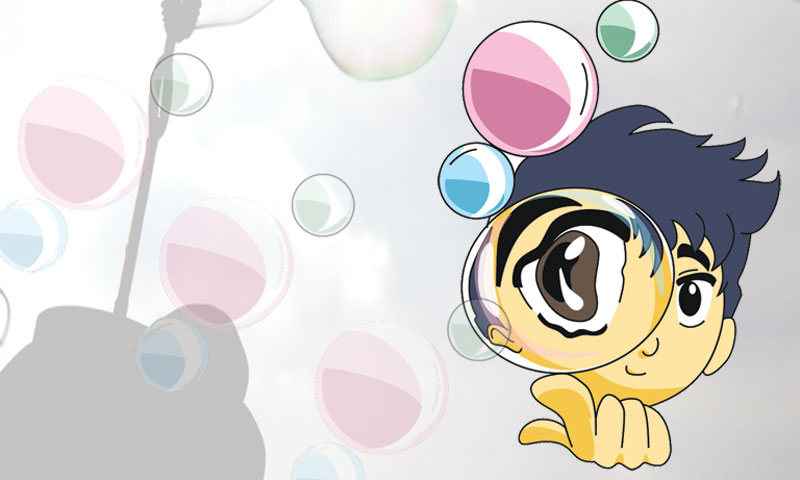FROM the foam on your cappuccino to soapy dishwashing liquid and even flavoured ‘bubble tea’, bubbles are all around us. Blowing bubbles has always been a fun way to spend a warm summer day. Yes, bubbles have always been something we all love and enjoy playing with. But how much do we really know about the colourful, soapy sphere that floats through the air?
Take a step into the bubbleology lab and find out! Let’s start with an introduction to our lab rat: The Bubble.
How do bubbles form?
A bubble is basically an extremely thin film of soapy water enclosing air that forms a hollow sphere with an iridescent surface.
The surface of water is made up of hundreds of water molecules that stick tightly together to each other because of inter-molecular forces and something that is called surface tension. This helps the water molecules to retain their shape and stay closely knit to one another.
Have you noticed that when soap is spilled over the floor, the floor becomes slippery? Well, in the same way when you add soap to the water molecules, it reduces the surface tension of the water molecules, their tight grasp on each other becomes slippery, allows the surface to stretch into a bubble which is easily formed when air from your mouth passes through.
Why are bubbles round?
Bubbles are round because, just like balloons, they are what scientists call ‘minimal surface structures’. What this means is that bubbles hold the air enclosed inside them in the least possible surface area that they can. Out of all the geometric shapes such as cubes, or pyramids, the geometric form with the least surface area is a round sphere! So sadly, it isn’t possible to make square-shaped bubbles.
Why do bubbles pop?
Bubbles pop when the water in the bubble evaporates. But here’s a secret! If you want stronger bubbles, try adding glycerine into the bubble solution! It strengthens the bubble by keeping the water from evaporating quickly. Another cool trick is if you wet your hand and then touch a bubble! It won’t burst!
Why are bubbles so colourful?
When you look at a bubble, you might notice the beautiful colours swirling around its shiny surface and wonder, where did all those colours come from? After all, the bubble was made from plain transparent water! The reason for the colours is actually the light that reflects off the water molecules of the bubble which makes its surface colourful.
What happens when two bubbles meet?
When two bubbles meet, it’s like two old friends are meeting each other. No, they don’t hug and say hello! Like you would share your toys with a friend, the bubbles share their volume with each other! To form the least possible surface area, the two bubbles will join together or if they are different sizes, even merge to form a bigger bubble.
What would happen to a bubble in space?
It’s a funny thought, imagine an astronaut in a big suit, blowing bubbles on the surface of the moon! Sadly, science has proved that bubbles cannot form in space due to lack of air pressure needed to blow a bubble. Because there are no air molecules for you to blow from your mouth to create the bubble, there would be nothing to make the bubble itself.
However, in a pressurised spacecraft, since there is oxygen present (so that the astronauts can breathe freely), a bubble can be blown normally as if on earth.
Can you freeze bubbles?
Since bubbles are made out of water, yes, they can freeze when exposed to temperatures below 32 degrees Fahrenheit, although the temperature would need to fall extremely quickly to freeze the bubble before it pops! If you’ve ever noticed that a thick liquid is frozen in a bowl, you might notice tiny round frozen bubbles on its surface proving that yes, bubbles can freeze!
You can even eat bubbles!
I’m not talking about soap bubbles here, but in many countries an interesting beverage has been introduced called ‘bubble tea’. Although it doesn’t actually include real bubbles like soap bubbles in the drink, at the bottom of the fruit-flavoured teas which originated in Taiwan, are tiny balls made of tapioca starch.
A new type known as ‘popping bobas’ are now being used and these are small balls that rest at the bottom of the drink that burst with juice flavour when you bite them, hence the name ‘bubble tea’.
Animals love bubbles too!
Bubbles might be something that all people know and cherish, but guess what? Animals make use of bubbles too! Several breeds of fish, including the male Siamese fighterfish, create bubble nests to house their eggs until they hatch into tiny baby fish. Siamese fighterfish are popular pets because of their magnificent bold colours, so buy a pair and maybe if you’re lucky you can watch them building their famous bubble nests!
Another animal that makes good use of bubbles is the snapping shrimp. But unlike the fighterfish’s bubble nests, this animal uses bubbles to catch prey! It sounds odd, doesn’t it?
But the snapping shrimp has a powerful specialised snapping claw which it clamps shut with such force that it creates a ‘cavitation bubble’. This cavitation bubble, as it spreads out from the claw can reach speeds of up to 60 miles an hour and release a sound of up to 218 decibels! This pressure of the bubble’s release (which is so loud that it is called a “pistol shot”) stuns small fish, which the shrimp pulls into its burrow and then feeds upon. The sound it generates is so loud that the small snapping shrimp has been titled the ‘loudest animal in the sea’, even louder than huge mammals such as the beluga whale!
And lastly, although blowing a bubble may not seem like much effort at all, think again! Here are some world records involving bubbles!
Most people inside a single bubble
In March 2007, Sam Heath (“Sam The Bubble Man”) made a Guinness World Record when he enclosed 19 people inside a single giant bubble in Surrey, UK.
Largest soap bubble ever made
In October 2005, John Erck blew the world’s largest free-floating soap bubble. It was so huge in size that if it could be filled with water, it could have held 788 gallons of water and 13,627 baseballs would have fit inside of it!
















































